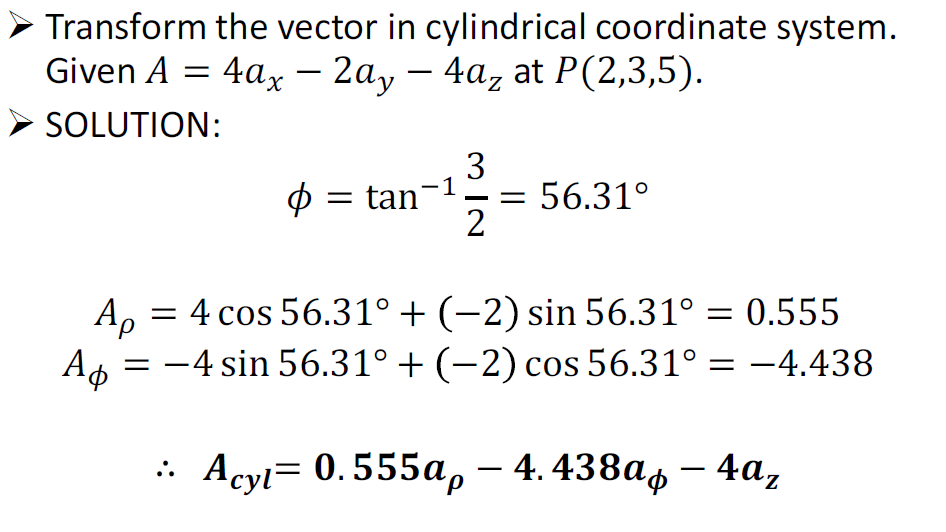Vector Projection; Space Coordinate System

Why is it that we have to provide a reference point \(P(x, y, z)\) to convert a Cartesian vector to a Cylindrical vector? Also, how would you interpret the vector \(A_\rho a_\rho + A_\phi a_\phi + A_z a_z \), geometrically?
No vote yet
2 votes
Easy Math Editor
This discussion board is a place to discuss our Daily Challenges and the math and science related to those challenges. Explanations are more than just a solution — they should explain the steps and thinking strategies that you used to obtain the solution. Comments should further the discussion of math and science.
When posting on Brilliant:
*italics*or_italics_**bold**or__bold__paragraph 1
paragraph 2
[example link](https://brilliant.org)> This is a quote# I indented these lines # 4 spaces, and now they show # up as a code block. print "hello world"\(...\)or\[...\]to ensure proper formatting.2 \times 32^{34}a_{i-1}\frac{2}{3}\sqrt{2}\sum_{i=1}^3\sin \theta\boxed{123}Comments
Cylindrical polar coordinates are defined in terms of an axis (the axis of the cylinder). The relationship between the fundamental Cartesian coordinate vectors ax,ay,az (which are unit vectors pointing along the x-, y- and z-axes) and the fundamental cylindrical polar coordinate vectors aρ,aϕ,az varies depending on the point where these vectors are being considered. While, for example, ax always points in the same direction, the vector aρ points in different directions at different points in space.
To be specific, if ax=(1,0,0), ay=(0,1,0) and az=(0,0,1). Suppose we are at the point P with coordinates (ρcosϕ,ρsinϕ,z).
aρ is the unit vector in the "direction of increasing ρ", namely the unit vector which is perpendicular to the z-axis and radially outwards, so aρ=(cosϕ,sinϕ,0).
aϕ is the unit vector in the "direction of increasing ϕ", namely the direction you would go if ϕ increases, while keeping ρ and z constant. If you keep ρ and z constant, you rotate about the z-axis, and so aϕ=(−sinϕ,cosϕ,0).
az is still the unit direction in the "direction of increasing z", namely (0,0,1).
If we are converting between the Cartesian and cylindrical polar systems, we are in the business of describing the same vector a in two different ways, and so a=Axax+Ayay+Azaz=Aρaρ+Aϕaϕ+Azaz Taking scalar products: AρAϕAz===a⋅aρ=Axcosϕ+Aysinϕa⋅aϕ=−Axsinϕ+Aycosϕa⋅az=Az The last equation is trivial, since the z-coordinate is the same coordinate in both coordinate systems. These are precisely the equations that are being used in the example you provided.
Log in to reply
Thank you Sir Mark :))